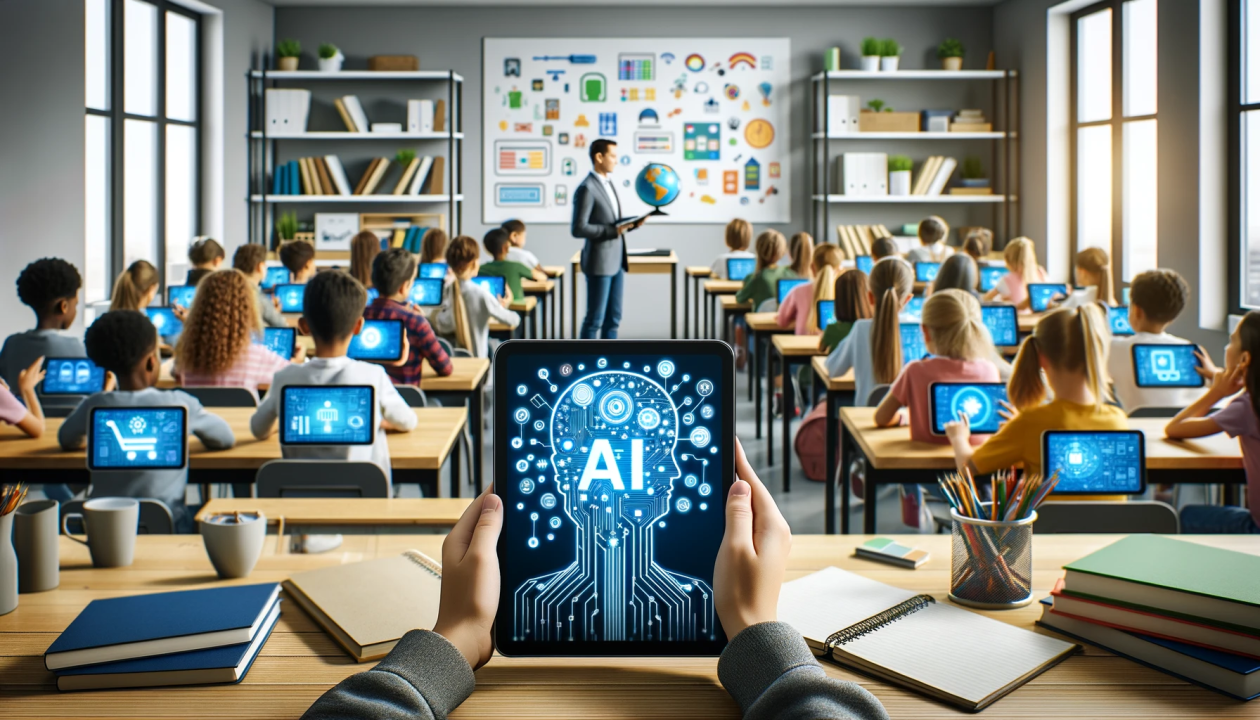A Comprehensive Guide to Integrating AI into the Classroom for Enhanced Student Engagement
Artificial Intelligence (AI) is rapidly becoming a transformative force in education, particularly in enhancing student engagement. As classrooms evolve to meet the needs of 21st-century learners, integrating AI effectively can create personalized, interactive, and engaging learning experiences. This comprehensive guide explores the various ways AI can be integrated into the classroom to boost student engagement, offering practical strategies and insights backed by recent research.
Understanding the Role of AI in Education:
Before delving into specific strategies, it’s essential to understand the broader role of AI in education. AI offers tools that can personalize learning, provide real-time feedback, and support teachers in managing diverse classrooms. By leveraging AI, educators can address the unique needs of each student, ultimately enhancing student engagement and academic success.
Key Insights:
- Personalization: AI-driven tools can analyze student data to tailor learning experiences, making education more relevant and engaging. These tools adapt to the pace and style of each learner, ensuring that no student is left behind.
- Feedback and Assessment: Real-time feedback through AI helps students understand concepts better and stay motivated in their learning journey. Immediate feedback is crucial in helping students correct mistakes and reinforcing learning.
- Support for Differentiated Instruction: AI supports differentiated instruction, allowing teachers to cater to varied learning paces and styles. This flexibility is key to maintaining student engagement in a diverse classroom setting.
According to the World Economic Forum, AI is expected to play a significant role in transforming education, with personalized learning becoming a key trend. This shift towards a more individualized learning approach is pivotal in ensuring that students remain engaged and motivated.
Strategies for Integrating AI into the Classroom:
Personalized Learning Platforms
One of the most impactful ways to integrate AI into the classroom is through personalized learning platforms. These platforms adapt to each student’s learning pace, strengths, and areas for improvement, offering tailored resources and activities. Personalized learning not only keeps students engaged but also ensures that they are continually challenged at the appropriate level.
How It Works:
- AI Algorithms: AI algorithms assess individual student performance, adjusting the difficulty of tasks based on real-time analysis of their progress. This continuous adaptation ensures that students are neither bored nor overwhelmed, striking the perfect balance to maintain engagement.
- Customized Learning Paths: Students receive customized learning paths that keep them engaged and challenged at the right level. These paths are designed to focus on areas where students need the most improvement while reinforcing their strengths.
- Teacher Support: Educators can track progress through comprehensive dashboards, allowing them to intervene with additional support or challenges as needed.
The RAND Corporation found that students using personalized learning environments outperformed their peers by up to 8 percentile points in math, demonstrating the effectiveness of this approach. This is particularly significant in subjects like AI in Mathematics, where personalized learning can help students master complex concepts at their own pace.
AI-Powered Feedback and Assessment
Providing timely and constructive feedback is crucial for student engagement. AI-powered assessment tools can offer immediate feedback on assignments, quizzes, and even complex tasks like essays, helping students learn from their mistakes quickly. These tools are particularly beneficial in large classrooms where individualized feedback from teachers may be challenging to provide consistently.
Benefits:
- Automated Grading: Automated grading reduces the workload on teachers, allowing them to focus on more personalized instruction and support for students who need it most.
- Immediate Feedback: Real-time feedback keeps students engaged by allowing them to see their progress instantly. This immediate response is crucial in helping students correct errors and understand concepts more deeply.
- Pattern Recognition: AI can identify patterns in student performance, providing insights into areas where students may need more help. This analysis can guide teachers in adjusting their instructional strategies to meet the needs of the class.
According to the International Journal of Artificial Intelligence in Education, AI-driven feedback systems can improve student learning outcomes by up to 30%, making it a powerful tool for enhancing engagement and academic performance.
Enhancing Student Engagement Through Interactive AI Tools
AI can enhance student engagement through interactive tools like virtual labs, simulations, and educational games. These tools make learning more interactive and fun, helping students stay motivated and interested in their studies. Interactive learning environments are particularly effective in STEM education, where hands-on experience can significantly enhance understanding.
Key Features:
- Virtual Labs: Virtual labs allow students to conduct experiments safely and without the need for physical resources. These labs provide a risk-free environment where students can explore and learn from mistakes without the fear of costly errors.
- AI-Driven Simulations: AI-driven simulations provide immersive learning experiences, making complex concepts easier to understand. For example, physics simulations can visually demonstrate principles like gravity or acceleration, making abstract concepts more tangible.
- Gamified Learning Platforms: Gamified learning platforms use AI to adapt challenges to the student’s level, maintaining a balance between fun and educational value. These platforms often include reward systems that motivate students to achieve more, thus enhancing engagement.
A study by EdTech Magazine revealed that interactive AI tools can increase student engagement by 20% compared to traditional learning methods, highlighting the importance of interactive technologies in modern education.
Implementing AI in the Classroom:

Start with a Pilot Program
To successfully integrate AI, start small with a pilot program. Choose one or two AI tools and implement them in a specific subject or class. Monitor the impact on student engagement and make adjustments as needed. This approach allows educators to assess the effectiveness of AI tools before a full-scale implementation.
- Tip: Involve teachers in the selection process to ensure the tools meet their needs and are easy to use. Teachers who are part of the decision-making process are more likely to embrace and effectively use new technologies.
Provide Professional Development for Educators
Teachers need to be comfortable with AI tools to use them effectively. Provide professional development opportunities that focus on how to integrate AI into daily teaching practices. Ongoing training ensures that teachers are not only proficient in using AI tools but also confident in leveraging them to enhance student engagement.
- Tip: Workshops, online courses, and peer learning sessions can help teachers gain confidence in using AI. Additionally, creating a support network where teachers can share experiences and strategies can foster a collaborative learning environment.
Collect and Analyze Data
Use the data generated by AI tools to analyze their impact on student engagement and learning outcomes. This data can inform future decisions on AI integration, helping educators refine their approaches for maximum effectiveness.
- Tip: Regularly review data with teachers to identify trends and areas for improvement. Collaborative data analysis sessions can help teachers understand how AI tools are affecting student engagement and learning, allowing for timely interventions.
The Brookings Institution emphasizes the importance of data-driven decision-making in education, especially when integrating new technologies like AI. Data not only provides insights into student performance but also guides the strategic implementation of AI in the classroom.
Challenges and Considerations:
While AI offers numerous benefits, there are also challenges to consider. These include ensuring data privacy, avoiding over-reliance on technology, and addressing the digital divide that may prevent some students from accessing AI tools. It’s crucial for educators to approach AI integration with a balanced perspective, weighing the benefits against the potential risks.
Considerations:
- Data Privacy: Implement strong data protection measures to safeguard student information. Schools must comply with data protection regulations such as GDPR or FERPA, ensuring that student data is handled securely.
- Balanced Use of Technology: Balance AI use with traditional teaching methods to maintain a holistic educational approach. While AI can enhance learning, it should not replace the valuable human interactions that are essential in education.
- Equitable Access: Ensure all students have access to the necessary technology to benefit from AI tools. This might involve providing devices to students from low-income families or ensuring that AI tools are accessible to students with disabilities.
According to the National Academy of Sciences, addressing the digital divide is crucial to ensuring equitable access to AI-driven education. Without addressing these challenges, the full potential of AI in enhancing student engagement cannot be realized.
Conclusion:
Integrating AI into the classroom has the potential to significantly enhance student engagement by providing personalized learning experiences, real-time feedback, and interactive tools. By following best practices and being mindful of potential challenges, educators can leverage AI to create more dynamic and effective learning environments.
As AI continues to evolve, its role in education will likely expand, offering even more opportunities to engage students and improve learning outcomes. The key is to start small, involve educators in the process, and continuously evaluate the impact to ensure that AI integration is effective and beneficial for all students.
Incorporating AI into STEM education not only improves student engagement but also ensures that education is more inclusive, interactive, and aligned with the demands of the modern world. The synergy between AI and education is crucial for developing the next generation of innovators and problem solvers.


